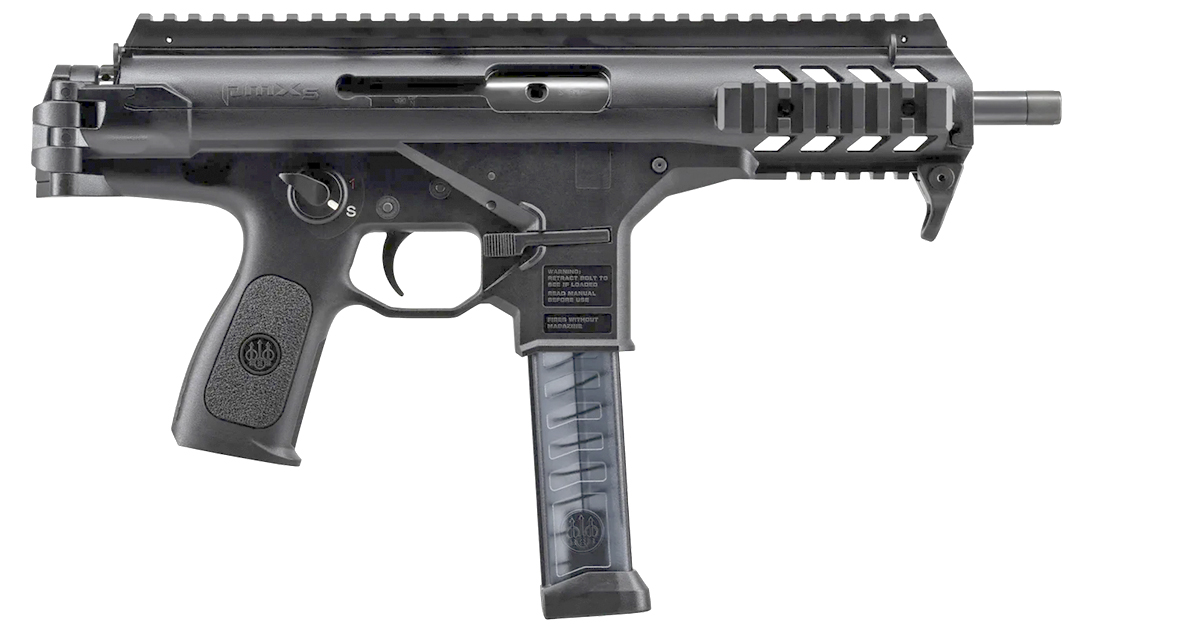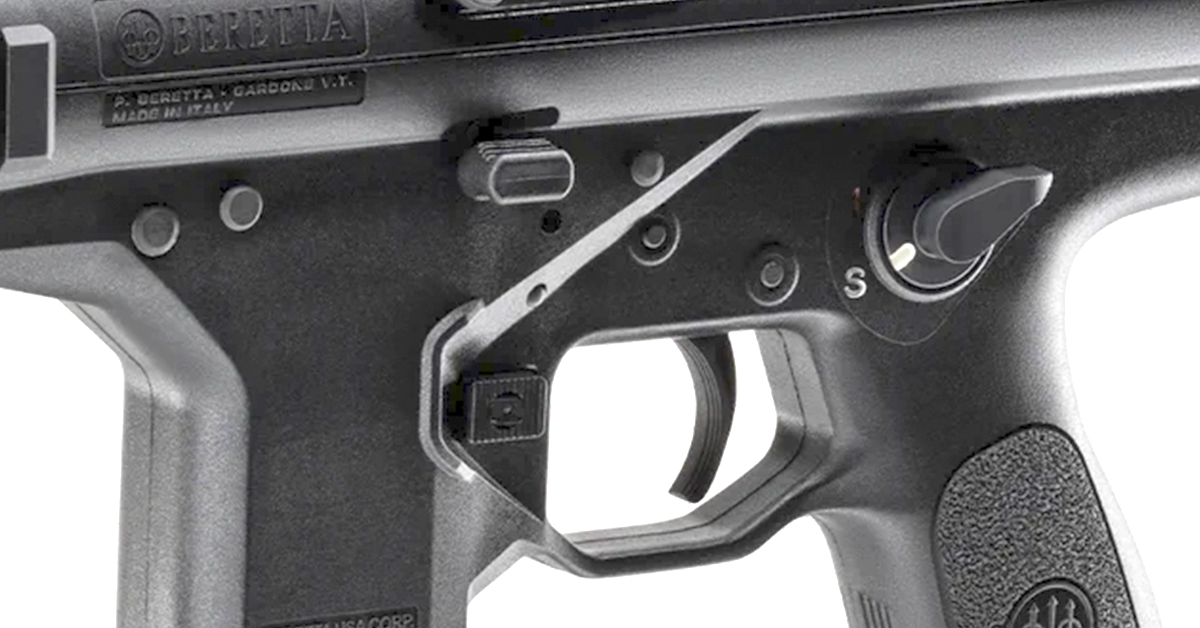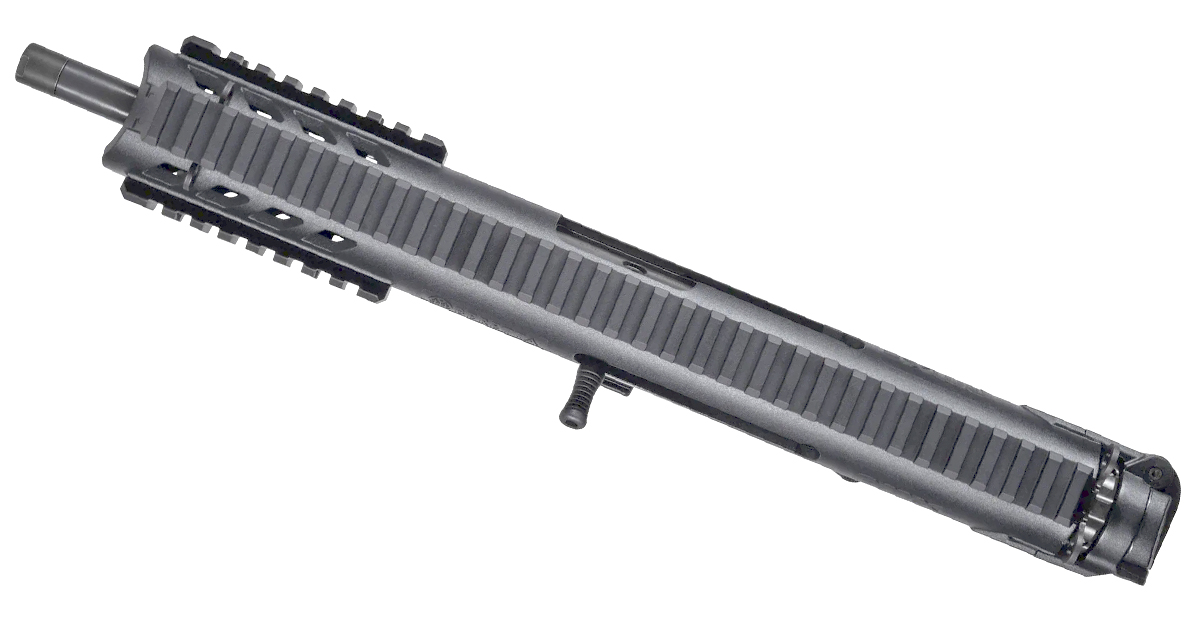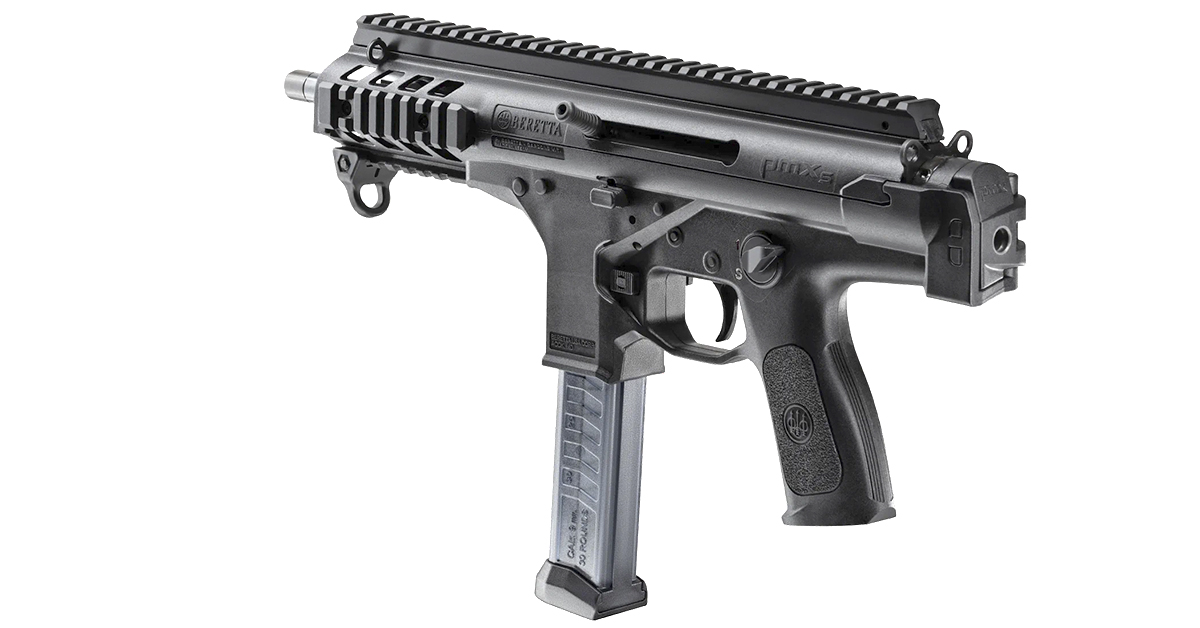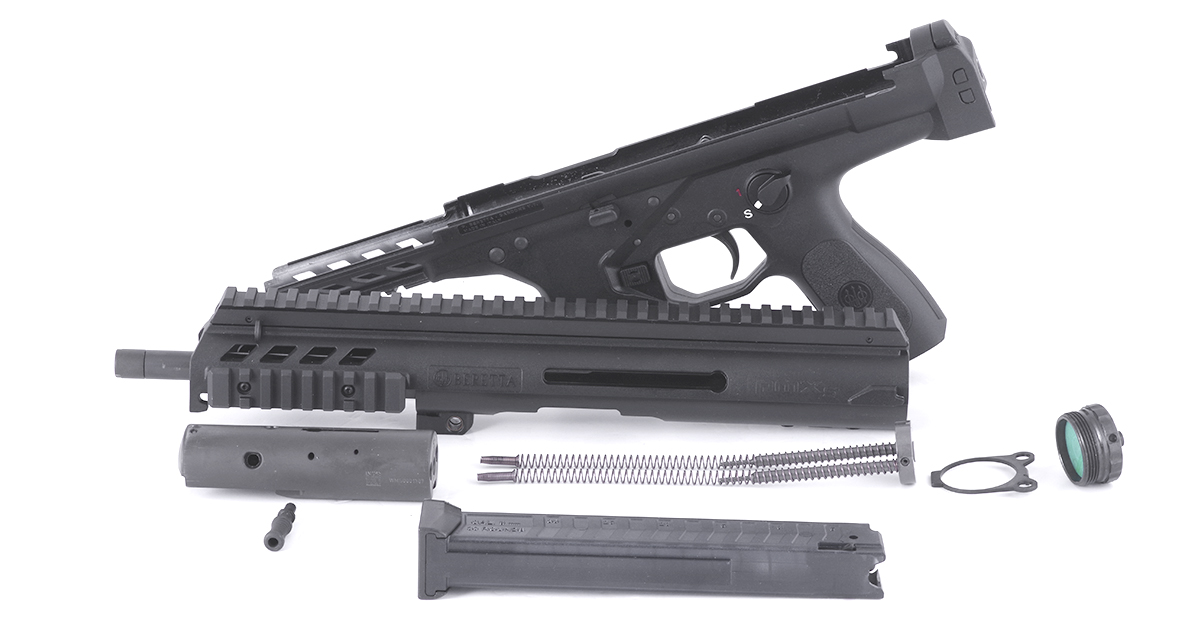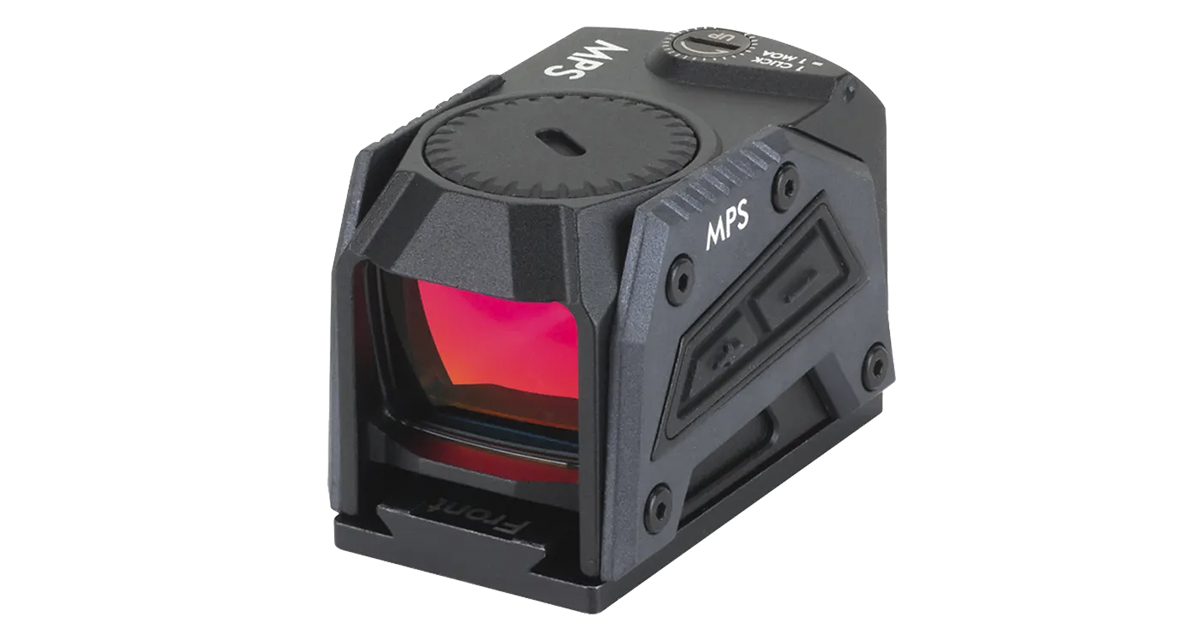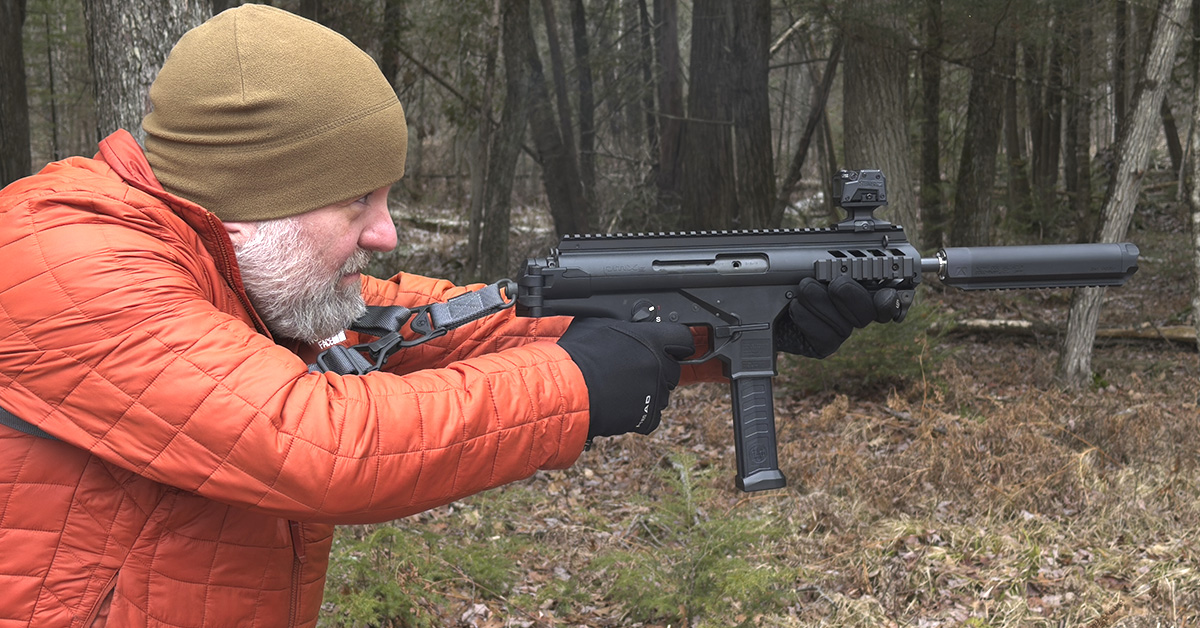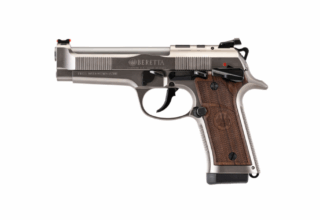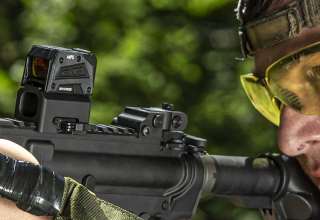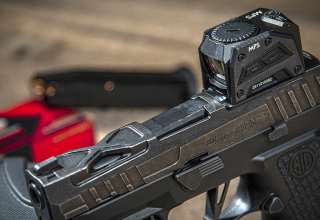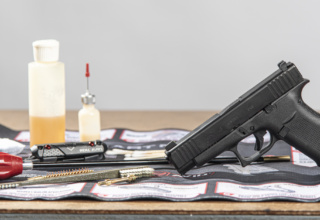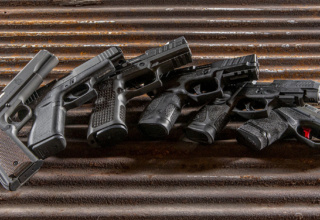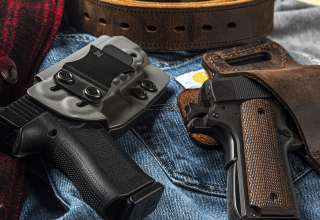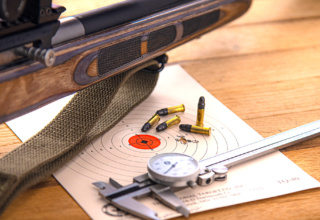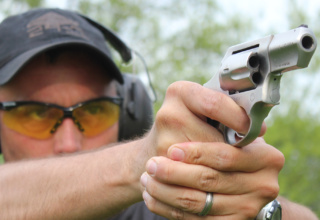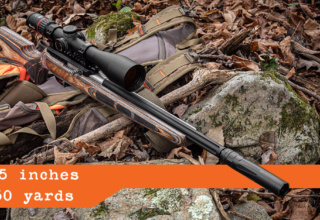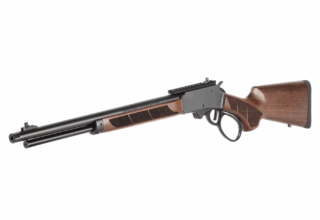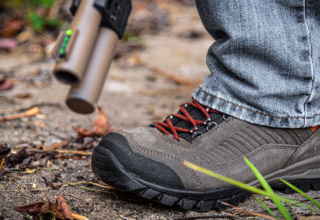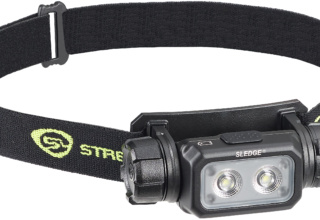The Beretta PMXs is a military-grade weapon designed for true professionals
by Robb Manning
One of the first things that struck me about the Beretta PMXs 9mm pistol is the tubular shaped receiver. Like an M3 Grease gun, it gives it a retro vibe. That’s a very different direction for Beretta, a company that in recent decades has focused on futuristic looking designs for most of their firearms. The PX4 Storm pistol and CX4 Storm carbine were fairly radical departures from traditional firearms aesthetics. They did dial it back a little with the APX.
The Beretta PMXs pistol is the semi-auto version of the PMX submachine gun. It’s designed for personal defense and/or sporting use. It uses a blowback-type locking mechanism.
The PMXs has two safety mechanisms. The first is a manual selector switch with two positions: “S” for safe and “1” for semi-auto (one round per trigger pull). The second is a firing pin block, which prevents the forward movement of the striker if it’s dropped. In other words, unless the trigger is pulled, the striker cannot move forward.
The PMXs controls are almost all ambidextrous with the exception of the bolt catch. The magazine release and manual safety are ambidextrous, and the reciprocating cocking handle is swappable for left- or right-side use. I’m not a huge fan of ambidextrous manual safeties because the left-hand safety (located on the right side) almost always digs into my finger, especially when it’s on safe and I have my index finger straight and out of the trigger guard. It’s not a big deal for short periods of time, but when carrying for extended periods, it can become an annoyance. I much prefer manual safeties that are swappable. With that said, this one on the PMXs is not as obtrusive as other designs on the market.
The trigger is excellent. It has a smooth take-up with a clean, crisp break. The trigger reset is short with a tactile and audible indicator. The trigger pull averaged 4.33 pounds out of ten pulls using a Timney Trigger High Range Trigger Tension Scale. The grip is comfortable in the hand and is based on the APX pistol.
There are four sling attachment rings, one fore and aft on both right and left sides. The rear cap has a flush cup as another attachment point and is the one I used for testing.
The gun sports four picatinny rails, each located at 12, 3, 6, and 9 o’clock. The one at 12 o’clock runs the entire length of the upper receiver. It comes with a finger stop located on the front of the 6 o’clock rail.
It has a cold-hammer-forged barrel made of high resistance steel for corrosion resistance and long service life. The 7.25-inch barrel has a 1/2-28 pitch thread to mount a suppressor, muzzle brake, or other applicable accessory.
The polymer 30-round magazine is easy to load. The feed lips are thick and heavy-duty. Breakage doesn’t appear to be an issue.
The PMXs has an MSRP starting at $1,299 and a street price of around $1,250. Some may scoff at that price as there are other offerings that are less pricey. It’s important to look at what the PMXs is, though, and what your needs are, before making that judgement. Firearms are designed for different purposes. Some are designed specifically for the civilian market. It’s a good strategy since US gun owners comprise a far larger group of people than most standing armies in the world. Some firearms are designed for both the civilian market and the professional market — and by professional, I mean military and police. These firearms are designed with the hope of drawing military/police contracts but are just as much designed for civilians. Some firearms are developed specifically for military use. These are often developed to the specifications of a specific military contract. Then perhaps the firearm could potentially be modified for sale on the civilian market.
The PMX falls into the latter category. It’s a true professional, military-grade weapon. It was designed specifically for military use, and it has been adopted and issued to military units. This equates to extensive testing for reliability and ruggedness. It’s unlikely that a civilian will ever put through the PMXs the number of rounds it was designed for, nor put it through the conditions it was designed for. Which means whatever usage you intend for it will be easy-peasy compared to what it was intended for. According to Beretta, the PMXs has passed NATO homologation stress tests.
The gun didn’t include a user manual, but instead had a two-page pamphlet with a QR code on one side to download a digital user manual and on the other side an order form to order a paper manual. At the time of this writing, the QR code takes you to the European website, and if you download the user manual from there, the PMXs is configured slightly differently, and includes 20-round magazines and iron flip-up sights. The US website does not have PMXs user manuals to download. I contacted Beretta about this and was informed this info was passed up the chain of command. Hopefully, they will rectify this.
Disassembly is very simple and user intuitive. No tools are required. Remove the magazine and make sure the gun is cleared, of course. On the right side, just in front of the mag well, is the disassembly pin. Press it and pull it out the other side (fingers work; if not, use a cartridge). Push the upper receiver forward about a quarter inch and lift up. Remove the rear cap group — it screws on and off. Pull the sling swivel off (it’s not attached, so you don’t want to lose it) making note of how it’s positioned. Pull the cocking handle back as far as it goes and pull it out through the notch in the upper receiver. The recoil spring group and bolt group will slide out — they are two different groups and aren’t attached to each other. Nothing in the lower assembly needs to be removed. To assemble, do the reverse.
Range Time
For testing, Steiner sent me their Micro Pistol Sight (MPS). It has 3.3 MOA red dot which can be adjusted easily for brightness with a rubber button mounted on the side. I used it in both bright and low-light conditions, and I didn’t have any issues seeing it. It’s adjustable with six day/night levels and two night vision modes. It automatically shuts off after thirteen hours, but this feature can be disabled if you choose.
The enclosed design makes it excellent in all weather conditions and is even water submergible to 33 feet (ten meters). Extra side walls make it extra durable. It’s adjustable for both windage and elevation with an adjustment range of 90 MOA (50 Mil) for both. One click equals one MOA. It uses a CR1632 battery and is rated for 13,000 hours on medium brightness.
It comes with a mounting plate that interfaces with the Doctor system mounting holes/plates. (Weapon-specific mounting adapters are available online). Mounting plates such as this, though, are for handguns, and don’t work with a SMG-type firearm like the PMXs.
To mount the Steiner MPS on the PMXs requires a riser-type mount, and Reptilia was kind enough to send me their Dot Mount for Acro. It’s a Lower 1/3 Co-Witness Optic mount. It’s a tough mount and worked perfectly with the MPS to mount on the PMXs.
Optimally, I would buy an SBR stamp and turn this into an SBR so I could use it with a stock. As an alternative, an arm brace would work well. I don’t own this PMXs, so neither choice was an option. The next best thing is using a sling, so I used the Magpul MS3 Single QD Gen2 Sling. Just as a properly utilized sling, when cinched tight, can steady a rifle shooter, a sling can also be used to make the PMXs steadier. I tightened the Magpul sling so that when I bring the PMXs to shoot, it’s positioned at the optimal distance that I’m most comfortable shooting it at. This happens to be approximately where it would be if it had a stock and I had it shouldered to fire. With the sling adjusted to where I want it, aiming and shooting the PMXs is simply a matter of pressing it away from my body, creating tension with the sling. This method isn’t as stable as a stock, but it’s far more stable than you might think it would be.
Weapons handling with the sling is not too much different than a stock. Bringing it up to fire is a similar motion to shouldering it to fire. Transitioning from target to target is also similar. The deficiencies that I’ve found in using this method aren’t because of stability with the PMXs; for me it has to do with cheek weld. There is none. It doesn’t have a stock, so there’s nothing to put my cheek on. It affects me the most when trying to attain the red dot — it takes longer. I do believe this is something that, if given enough time behind the trigger to develop muscle memory, this deficiency can be overcome by training.
The PMXs makes an excellent host for a suppressor. I used a SIG SAUER 9mm suppressor and an Alpha Dog suppressor, and the PMXs functioned smooth as butter with both. I didn’t feel any noticeable blowback when I used either of them.
Final Thoughts
Beretta did an excellent job with the design of the PMX, as well as bringing it to the civilian market with the PMXs. Aside from the minor complaint I made about the manual safety, I found no issues with the PMXs and thought it performed exemplary.
The biggest complaint that I have is not about the PMXs itself, but how it is packaged. Mine didn’t come with any flip-up sights, or sights of any kind, for that matter. I firmly believe that when a consumer buys a tactical or defense type firearm — whether it be a handgun, PDW, etc. — it should be ready to go out of the box. It’s not ready to go if it doesn’t have sights. It should be noted that the PMXs offered to civilians in the European market comes with iron flip-up sights.
I’ve fired several different offerings of this genre of 9mm pistols — semi-auto versions of SMGs — and I’ve enjoyed shooting most of them. But the PMXs is the most shootable of them all. The action is the smoothest, and I don’t recall a better trigger on any of them. I have my long-time favorite, but I do believe the PMXs has bumped it out of the top spot.
Performance Data
- Federal Syntec 124-gr. / 3.29 in. (50 yds.), 4.93 in. (100 yds.) / 1294.2 avg. vel.
- Liberty Overwatch 72-gr. / 2.94 in. (50 yds.), 6.31 in. (100 yds.) / 1889.3 avg. vel.
- SIG FMJ 124-gr. / 3.50 in. (50 yds), 5.45 in. (100 yds) / 1297.2 avg. vel.
* Accuracy at 50 yards is tested using five 5-shot groups from a rest. At 100 yards, one 5-shot group. Velocity is an average of ten shots.
Beretta PMXs Specifications
- Caliber: 9x19mm Luger
- Operating System: blowback
- Magazine Capacity: 30-round
- Action: semi-automatic
- Lower Receiver: polymer
- Upper Receiver: steel w/polymer shroud
- Barrel: cold-hammer-forged
- Trigger: single-action only
- Sights: none
- Barrel Length: 7.25 in.
- Height: 9.75 in. (magazine inserted, no sights)
- Width: 2.8 in. (at charging handle)
- Overall Length: 16.75 in.
- Weight: 5.1 lbs. (with empty magazine)
- MSRP: $1299
- TESTED: Beretta PMXs 9mm Pistol - July 26, 2024
- The Correct Way to Clean a GLOCK - January 15, 2024
- Concealed Carry Guns: How Important is Ergonomics? - December 11, 2023

